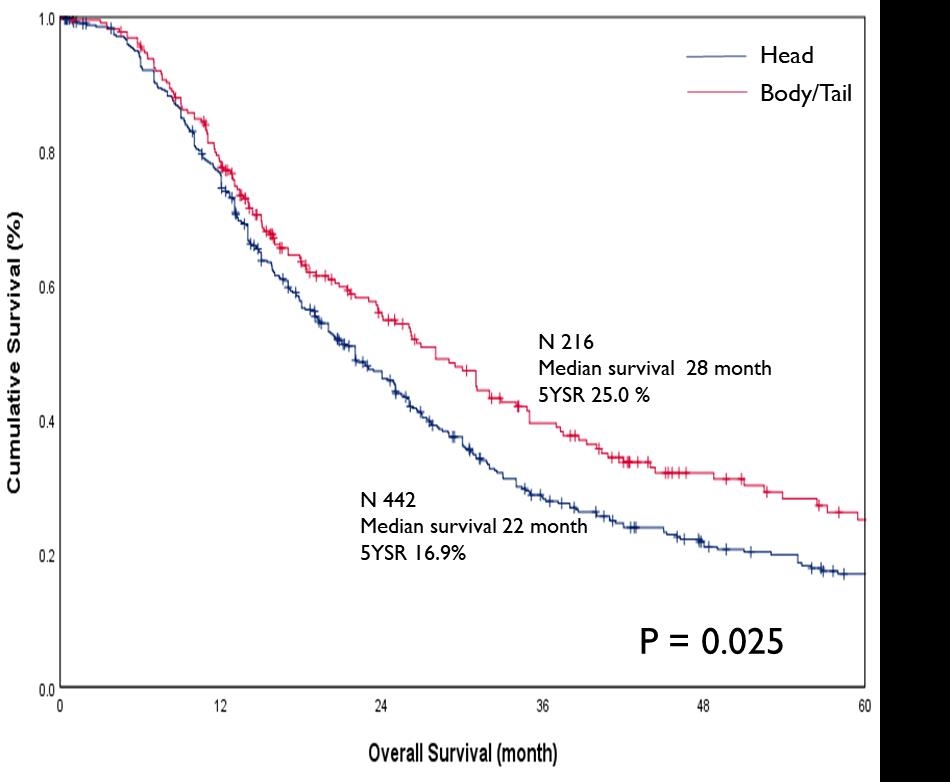IS PANCREATIC CANCER DIFFERENT ACCORDING TO THE LOCATION?; A SURVIVAL AND PROGNOSTIC FACTOR ANALYSIS
Mirang Lee*, Wooil Kwon
Department of Surgery, Seoul National University Hospital, Seoul, Korea (the Republic of)
Background: AJCC pancreatic cancer staging system is equally applied to both head cancer and body/tail cancer. However, there are conflicting results regarding whether pancreas head cancer and distal pancreatic cancer have similar prognosis. The study aims to investigate the validity of the pancreatic cancer staging system in all locations and to compare the survival and prognostic factors of pancreatic cancer according to the location.
Methods: Patients operated with curative intent for pancreatic cancer between 2005 and 2016 in Seoul National University Hospital were examined. Demographics, clinicopathologic, and survival data of 658 eligible patients were retrieved for analysis. Survival analysis and univariate and multivariate analyses were performed.
Results: Tumor was found in the head (including uncinate process) portion in 442 patients (67.2%), and in the body/tail in 216 (32.8%). R0 was achieved in 84.0%, R1 in 15.8%, and R2 in 3.8%. Adjuvant treatment was given to 78.4% of the patients.
There were no differences in terms of R status and receiving adjuvant treatment. Well-differentiated tumors were more frequent in the body/tail (p=0.015). The body/tail cancers had more T3/4 tumors (25.9% vs. 17.0%, p=0.007) whereas the head cancers had more T1/2 tumors (83.1% vs. 74.1%, p=0.007). Head cancers had more nodal metastasis (64.2% vs. 57.5%) but was insignificant (p=0.100).
The new system demonstrated reasonable performance. It was valid for overall pancreatic cancer and was effective for both head cancers and body/tail cancers.
The body/tail cancers showed significantly longer median survival (28 vs. 22 months, p=0.025) and higher 5YSR (25.0% vs. 16.9%). Survival comparison across each T/N category, and stage showed no differences except for T2. T2 body/tail cancers displayed significantly better outcome (median survival; 31 vs. 21 months, p=0.006) than T2 head cancers. Among documented recurrences, distant metastasis was more frequent than local recurrence in the body/tail compared to the head (91.1% vs. 78.4%, p=0.013).
Histologic grade, T category, N category, radiotherapy, and preoperative CA19-9 were prognostic factors shared by tumors of both locations. Angiolymphatic and perineural invasion, and chemotherapy were additional prognostic factor in head cancers. Gross type, margin status, and venous invasion were distinctive of body/tail cancers.
Conclusion: The 8th edition AJCC staging system is valid for pancreatic cancer regardless of the location. However, despite having more of T1/2 tumors, the head cancer had worse outcome than the body/tail cancer. In addition, tumors showed different recurrence patterns. Further, while they share some prognostic factors, there are some that are distinctive of the location. Therefore, there may be a need to consider pancreas head cancer and body/tail cancer as cancers of distinct tumor biology.
Back to 2019 Posters




